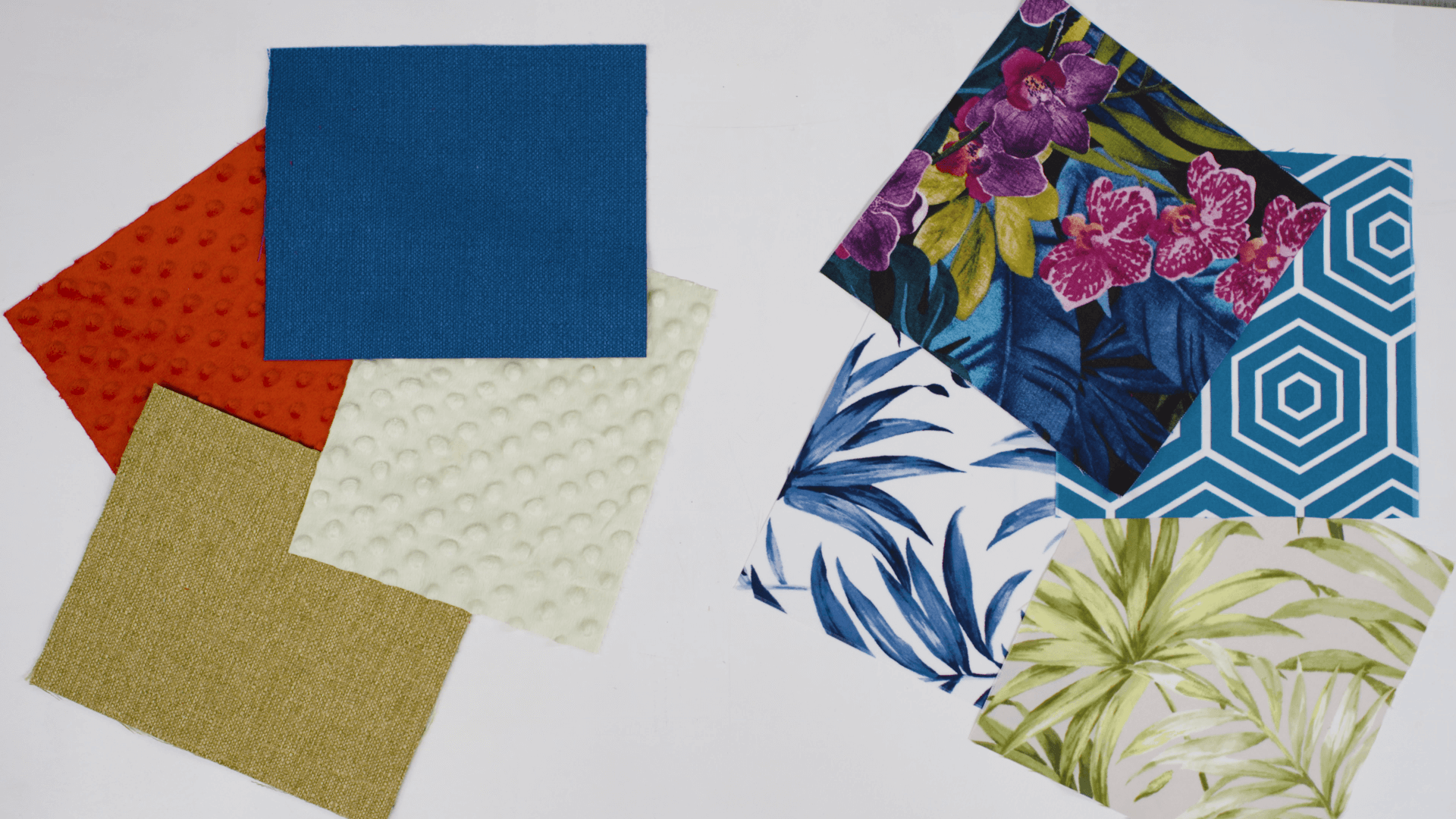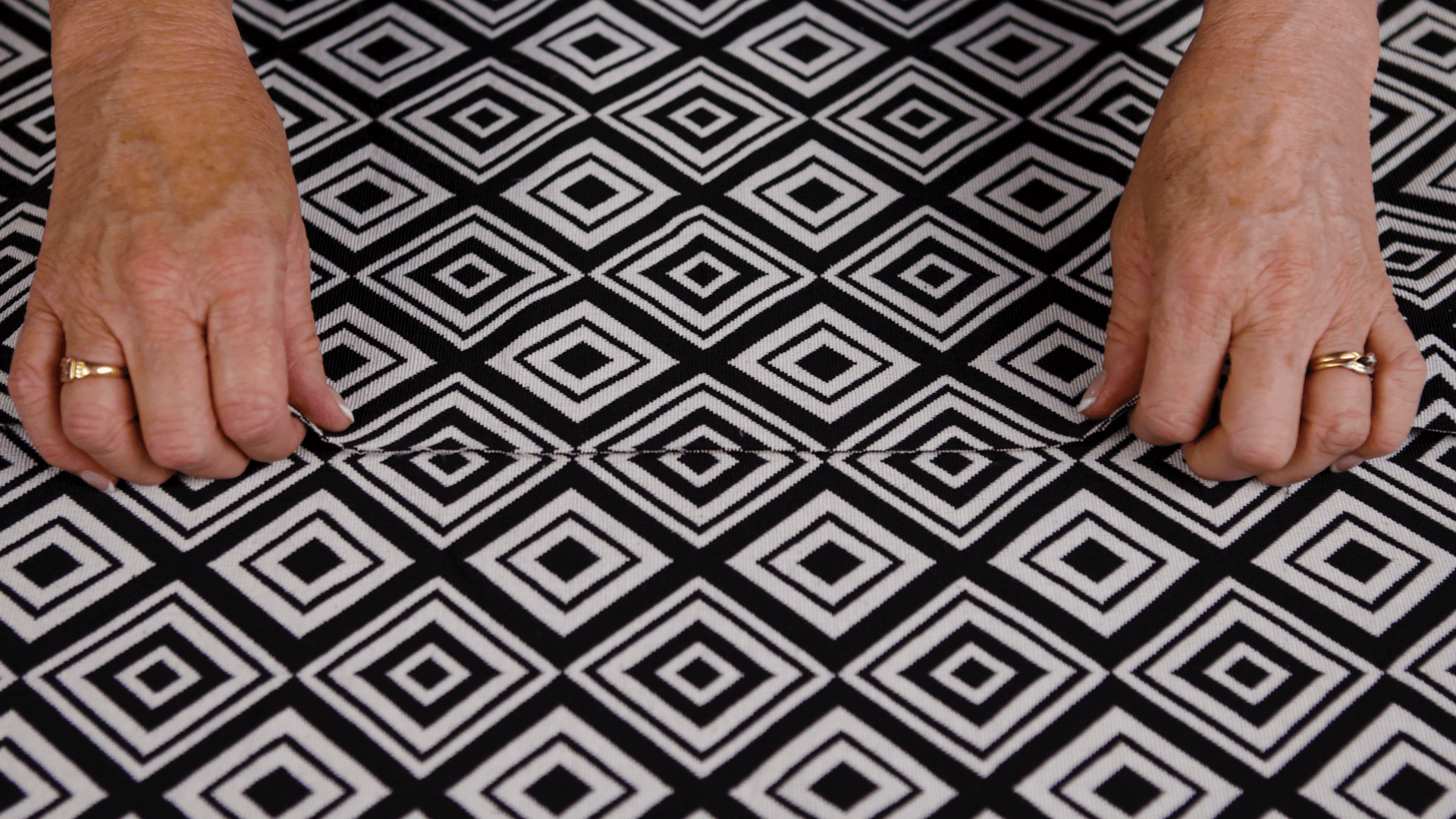 | ||
| Your browser is not supported. | ||
|
Please browse our site using any of the following options:
| ||
How To Choose Upholstery Fabric
Designing, making or restoring home furnishings is the ultimate way to make your space your own. Get the results you want by choosing the right fabric for each task from the huge range of fabrics at Spotlight.
When choosing a fabric for your project, it's important to consider where how the item will be used, and where it will be placed in your home. These factors will help you choose a fabric you love that will not only look good but also stand the test of time.
Quick Links
- What Is Upholstery Fabric?
- What Is The Difference Between Upholstery And Decorator Fabrics?
- What Are The Types Of Upholstery Fabrics?
- How Does Fabric Wear?
What Is Upholstery Fabric?
Upholstery fabrics are the textiles used to reupholster furniture. This means they are the protective and decorative fabrics you see on couches, chairs, footstools and other pieces of furniture that cover the padding, springs and frame of the piece and make it comfortable to sit on. There are many different kinds of upholstery fabrics available at Spotlight, with a great variety of colours, patterns and prints available in natural and synthetic materials.
Synthetic vs natural upholstery fabrics
Whether fabric is synthetic or natural will have an effect on how it wears, looks and feels, as well as indicating the best ways to use it in your home.
Synthetic upholstery fabric
These man-made fibres are generally strong and wear well. They are easier to clean than most natural fibres, with most being suitable for cleaning in your washing machine on the appropriate cycle (if they're not already attached to your furniture!). Synthetic fibres are usually more affordable than natural ones, but as they are made of plastic they are not as environmentally friendly as natural fibres. If you ever need to dispose of your synthetic upholstery fabrics, look for local recycling options that take synthetic fabrics. They are generally quite durable, and are a great choice as an outdoor fabric upholstery material.
Natural upholstery fabric
Natural fibres are more breathable and soft than synthetics so can be more comfortable to sit on, especially in warmer weather. They usually have a more luxurious feel than synthetic fibres and will feel nice against your skin. Many natural fibres are very absorbent, which means they take fabric dyes very well and come in an array of vibrant colours, but they can also stain easily and be harder to clean. They can be prone to fading, and so should be used for pieces that will be positioned out of direct sunlight. You may like to apply an upholstery fabric protector to them to help keep them in good condition.
Blended upholstery fabrics
Many fabrics have a blend of natural and synthetic fibres. This combines the best qualities of each of the fibres and should help eliminate the drawbacks, although always check the care instructions of your blended fabric to ensure you are taking care of it properly.
What Is The Difference Between Upholstery And Decorator Fabrics?

Both upholstery and decorator fabrics are more durable than dressmaking fabrics and are designed for use around the house and for accessories. But there are important differences you need to be aware of before purchasing either of them!
Upholstery fabrics
Quality upholstery fabrics are heavy, thick and durable, with a tighter weave that gives them strength and durability. Most upholstery fabrics are designed for heavy use and should resist pilling, and once they are on your furniture, they can be spot cleaned with special upholstery cleaning products like aerosol sprays or water mixes. Upholstery fabrics come in many plain and patterned varieties, so you will always be able to find a fabric to suit your home decor and sense of style.
Decorator fabrics
Also, heavier than dressmaking fabrics, decorator fabrics lend themselves to more decorative pieces of furniture like cushions and dust covers, as well as quilts, tapestries and even accessories like hats and bags. While they can be used for furniture, they are not quite as strong or durable as upholstery fabrics and so may pill or even tear through overuse.
What Are The Types Of Upholstery Fabrics?

All of these fabrics come in a range of weights and treatments, so remember to look at the weave, feel the texture, and check the double-rub score on the end of the bolt to determine whether a particular choice is suitable for your project.
Chenille upholstery fabric
Upholstery chenille is tightly woven, which gives it a plush, textural look, with a soft and fuzzy feel. It can be made either from natural or synthetic fibres so it is available at a range of price points. Chenille can wear out quickly, so avoid using this upholstery material for furniture you'll be using often. Instead, reserve this lovely material for a bedhead or bedroom chair. Chenille can fade in the sun, so keep chenille upholstery fabric indoors and out of direct sunlight when inside. It is also tricky to clean, so keep it out of areas where it might be dirty, like the kitchen or dining room!
Cotton upholstery fabric
Cotton is a very breathable, soft natural material that is great for sitting on in hotter weather, as the material conducts heat and sweat away from your skin and into the air. Quality cotton, or cotton blended with another material, will resist pilling and thinning due to excess use, making it great for use in areas of high traffic in your home. Cotton holds dye well, so it also comes in an array of beautiful colours! Use heavier-weight cotton for covering couches, chairs and other furniture, and lighter-weight cotton for soft furnishings. Dyed cotton can fade in the sun, so keep any furniture upholstered with colourful cotton out of direct sunlight. And while cotton is prone to wrinkling, cotton pulled tight in the upholstery process will hold its shape perfectly.
Faux leather upholstery fabric
Faux leather is cheaper than natural leather while retaining a similar look, although it doesn't feel the same as natural leather when touched. It is made of polyurethane, vinyl, or PVC. Of these three, polyurethane is the more environmentally friendly option as it will biodegrade. Faux leather is easy to wipe down, so is great to use in spaces where spills and stains are likely to occur, and it doesn't need to be oiled or conditioned like natural leather. This low-maintenance material can crack and peel if exposed to prolonged exposure to direct sunlight, however, so use it for pieces that will be positioned out of the sun.
Jute upholstery fabric
Jute is a natural fibre that has a rough, rustic look and feel. It is quite durable, and it can be used for covering furniture and is also used in various weaves and thicknesses to make rugs, table runners and other soft furnishings. Use it in combination with wood, leather, and other similar materials to create a natural, earthy atmosphere in your home. It is breathable and absorbent, which ensures you can sit on jute furniture for long periods of time without becoming sticky and sweaty.
Leather upholstery fabric
Made from animal hide, leather is a natural upholstery material. It is prized for its soft, supple feel and distinctive aroma. If properly conditioned and cared for, leather is a very long-lasting material that will develop character and even become softer as it ages. Leather upholstery is prized for its hypoallergenic properties, as it will repel, dust, dirt and dander, and most spills can be cleaned off quickly with a damp cloth. Leather upholstery can be scratched easily, and it will show clearly! So be careful choosing leather furniture if you have pets or young children.
Linen upholstery fabric
Linen is a natural plant-based fibre that is both strong and soft. Linen upholstery fabric is often blended with cotton for extra softness and stretch, as linen gives cotton greater strength, and cotton gives linen greater flexibility. While it may not have the extended durability of some synthetic fibres, linen is the longest-wearing plant-based fibre and will stand up to moderate household use. Linen upholstery fabric has 'slubs' in its weave, which are slightly raised bumps made by the unevenness of the woven fibres. This creates a textured look that works well in rustic and relaxed spaces. Linen and cotton materials are sometimes referred to as canvas upholstery materials when designed for outdoor use.
Microfibre upholstery fabric
Microfiber is a densely woven synthetic fibre with a suede look. It has the benefits of synthetic fabrics, including being inexpensive, water-resistant, easy to clean, and fade-resistant, while also being comfortable and soft. It is also quite durable, and quality microfibre upholstery fabric will resist the claws of your bored pet or the yanking of young children. However it does sometimes have a 'static' feel that can attract dust and fluff to stick on your couch. Use microfiber fabric to create a modern-casual look for couches, armchairs and chaise lounges.
Olefin upholstery fabric
Olefin is a strong synthetic fibre that is colourfast, UV resistant and strong against stains, abrasion, and fading. This tough fabric can withstand heavy use, which makes it a popular outdoor fabric upholstery choice for furniture, like cushions and seating covers. You'll also see it used for outdoor umbrellas and car seat coverings and upholstery. It has a pleasantly rough texture and soft feel, so you'll always enjoy sitting on olefin upholstery fabric around the pool or when dining outdoors. While it is safe to keep in direct sunlight, olefin upholstery fabric can warp or melt under extremely hot temperatures, so be mindful on the hottest of days to drag your olefin-covered recliner or cushions into the shade.
Silk upholstery fabric
Silk is a natural fibre that can be spun and woven in a wide variety of ways to create fabrics as different as burlap, velvet, and brocade. While it can feel luxurious and look beautiful, silk is not hard-wearing. It is prone to staining and is easily damaged by moisture, light, and abrasion. As such, it is better used for decorative accents and formal pieces that are rarely used, like extra chairs at the dining table or even as a lampshade. Silk is a luminous upholstery material that takes on colour well, so is perfect if you've got a statement piece of furniture you want to show off.
Suede upholstery fabric
Sude is a super soft material traditionally made from leather, with a napped finish and a range of beautiful natural colours available. You can also find faux suede, often called leatherette or suedette, that is made from synthetic materials like polyester to mimic the feel of leather suede while not costing nearly as much. Suede should be waterproofed and stain-protected using an upholstery fabric protector, and only ever spot cleaned or dry cleaned if needed. Suede is a durable and elegant material that offers a timeless look for any furniture thanks to its matte finish.
Tapestry upholstery fabric
Used in the past to create impressive and insulating wall hangings, tapestry fabrics feature detailed and intricate designs perfect for creating a piece you want to draw attention with. This loosely-woven fabric can be made from natural or synthetic fibres, although larger hanging tapestries should not be cleaned in a washing machine, as this can cause it to lose its shape. Tapestry fabric is known for its patterns and prints - you can find scenic, nature-inspired and floral upholstery fabric in this material.
Velvet upholstery fabric
Velvet fabric for upholstery can be made from a range of natural and synthetic fibres. It is soft to the touch and gives a feeling of opulence to any space - you'll love running your hands over any furniture made from this material! The durability of velvet fabric for upholstery will vary according to the fibres from which it is made, so check its composition before you buy. Velvet can be difficult to clean and it also is quick to show signs of wear and tear, so it may be best to use velvet fabric for upholstery on pieces of furniture that aren't heavily used.
Wool upholstery fabric
Wool can be woven into a huge variety of weights and finishes from tweed to felt, jacquard, and twill. This makes it one of the most versatile natural fibres to upholster with.
Depending on its weave and finish, wool can be remarkably durable, and withstand moderate domestic use. Wool can be somewhat difficult to maintain as it is not colourfast, needs to be dry cleaned, and can attract moths. Blending it with synthetic fibres can mitigate most of these problems.
Polyester, rayon, and nylon are commonly used in upholstery fabric blends. They reduce the cost of natural fabrics and help make them more durable and stain resistant.
Once you know how a fabric will perform and whether it's suitable for your space, you can have fun playing with all the colours, textures and prints available.
How Does Fabric Wear?

The industry standard for testing fabric durability is the Martindale or "double rub" test. This test applies friction to the fabric in a controlled way and measures how long it takes before the fabric starts to show wear. Wear can be in the form of pills, (small balls of fabric), physical tears or just a thinning of the fabric in areas of use.
Double rub score | Intended use | Example pieces |
Up to 10,000 | Decorative | Throw cushions Decorative accents |
10,000 to 15,000 | Light domestic | Formal dining chairs Bar stools Bed headboards |
15,000 to 25,000 | General domestic | Couches Pouffes and footstools Beanbag covers |
Over 25,000 | Heavy-duty domestic to industrial | Couches Outdoor furniture |
You can find a fabric's double rub score on the end of the bolt in a Spotlight store.
Discover The Right Upholstery Fabrics At Spotlight
If you're ready to start reupholstering, choose your upholstery fabric online, pay your way and we'll deliver it straight to your front door. You can also visit your local Spotlight store, where our friendly team will help you choose the right upholstery fabric for your next project.
If you need some ideas on how to use your new upholstery fabric, check through our amazing furnishing fabric projects for heaps of step-by-step ideas, as well as our furnishings and trims category for any extras you'll need. And don't forget our Create and Decorate blogs for heaps of inspiration and tips on how to use your new upholstery fabrics!




